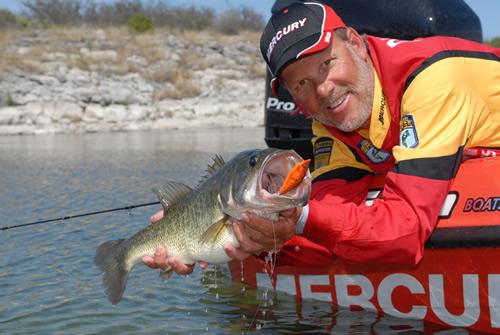
November 10, 2017 - It's never a bad idea to check the daily bag and size limits when you visit a Texas bass lake for the first time, particularly if you plan to keep a few fish for the freezer or hope to catch a trophy to mount. That's because limits can vary from lake to lake. A fish that is perfectly legal to toss on the livewell on one lake may not be legal on another lake.
Currently, close to 80 percent of Texas public reservoirs 500 acres or larger in size are managed by the statewide five fish, 14-inch length limit that the Texas Parks and Wildlife Department put in place in the mid-1980s. However, more than two dozen (30) lakes have "special limits" that are designed to suit bass populations at individual lakes or to help meet specific management goals. Among them are higher minimum length limits, varied slot limits and total catch and release.
If TPWD inland fisheries managers have their way, the number of Texas lakes with special limits could be reduced by this time year as biologists look for ways to streamline bass regulations without hampering the management goals on individual lakes.
TPWD Fisheries managers briefed the TPW Commission on the possible changes during a work session held ahead of last week's regional public hearing in Lufkin. The changes could impact largemouth bass regulations on several lakes in eastern Texas.
“Largemouth bass are one of the first species we started managing in the state, and we’ve done a great job managing our bass fisheries through time,” said Dave Terre, TPWD Chief of Inland Fisheries Management and Research. “Our process has been to use different kinds of regulations for bass to accomplish specific management goals. With these potential changes, we still hope to attain the same management goals, but we are trying to reduce the number and kinds of special regulations with the goal of making them less complicated, more easily understood and enforceable.”
Managers say 12 lakes currently under special limits could be placed under the statewide 5-14 rule and another half dozen could see a revised special limit that is better suited to the current bass population dynamics.
East Texas lakes that could revert to the 5-14 regulation include Ratcliff, Bryan, Cooper, Madisonville, San Augustine and Old Mount Pleasant. Lakes Granbury, Possum Kingdom, Bridgeport, Burk-Crenshaw, Georgetown and Sweetwater also are being considered for the 5-14.
Five of the eight six lakes where special limits could be revised also are located in East Texas. On Fayette County, Gibbons Creek and Monticello, fisheries managers are considering changing the current 14-24 inch slot limit to a 16-24 inch slot. On Purtis Creek and Raven - both state park impoundments - a five-fish, 16-inch maximum length limit is being considered over the current catch and release only rule. Bass longer than 24 inches caught from any of the six lakes would be eligible for submission to the Toyota ShareLunker program.
The final three lakes on the list for a possible change include Lake Grapevine, Davey Crockett and Bellwood. On Grapevine, officials are considering no minimum length limit with a bag limit of five fish, of which only two can be less than 18 inches. Both Bellwood and Davey Crockett are being considered for the five fish, 16 inch maximum reg.
If approved by the Commission in January, the possible changes will become become formal proposals and go up for public comment next spring. Constituents also can comment now by contacting Terre at 512-389-4855 or dave.terre@tpwd.texas.gov.
CWD deer regs to abide by
Texas hunters headed out to hunt in areas of the state where chronic wasting disease management zones have been established are reminded that they are required to bring harvested animals to a designated a Texas Parks and Wildlife Department check station within 48 hours of when the harvest takes place.
According to TPWD reports, the rule applies to hunters who take white-tailed deer, mule deer, elk, red deer or other CWD susceptible species within the Trans-Pecos, Panhandle and South-Central Texas CWD Containment and Surveillance Zones.
While check-ins are not mandatory outside these areas, the department is urging hunters make harvested deer available to wildlife biologists for voluntary sampling in other areas of the state, including East Texas.
Additionally, hunters are reminded of rules that ban the importation of certain deer, elk, and other CWD susceptible species carcass parts from states where the disease has been detected, as well as the movement of the same carcass parts from CWD zones. More information about CWD Management and Regulations for Hunters is available on TPWD’s web site.









